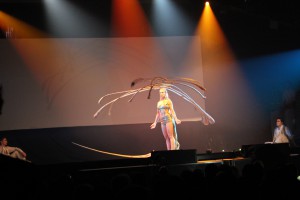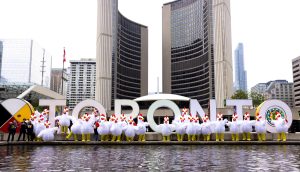On the second afternoon of the C2-MTL conference in Montreal, which is all about the intersection of commerce and creativity, Ian Schrager, hailed as the man who created boutique hotels and one of the founders of the infamous Studio 54, took to the stage to show off some of his creations.
He likened the hotel industry to the iPad, noting that other companies have been trying to sell similar products for 20 years, but Apple elevated the experience. It isn’t about the money, that will come if you make a good product, he said, also noting that design isn’t about the veneer, but about how it makes people feel. And like in the film industry, special effects won’t save a film if it’s poorly conceived and written.
“Edison didn’t ask people if they needed a light bulb, Steve Jobs didn’t ask if they needed a personal computer,” he said, adding you should do things for yourself and hope people will have the same thinking.
Up next was the Fast Company Storytellers panel, consisting of Rachel Shechtman, founder of the New York store Story; Andrew Wilson, VP at EA Sports; and Masashi Kawamura, CD and co-founder of Tokyo and New York-based agency Party Inc.
The panel covered a hot topic – how storytelling impacts business. The moderator, Fast Company staff editor Teressa Iezzi, noted how brand storytelling used to be centred around a commercial, but now technology has disrupted that.
Kawamura shared his unique agency model – instead of teams of art directors and copywriters, it employs teams of creative directors and technology directors. The idea is to combine the story with the right tool, he explained.
Shechtman talked about her own unique model: a retail store based around the idea of storytelling. Story is a physical store in Chelsea in New York City that completely changes every four to six weeks, based around a story which can be influenced by a sponsor. For instance, Benjamin Moore came on board and they created a “colour story” to launch a new palette of paints. (As an interesting anecdote, she also talked about how she convinced New York-based graphic designer Stefan Sagmeister to design her logo by helping with the marketing of his film.)
Wilson likened Sports to the longest running soap opera, one with such an intense level of interaction it can transcend other relationships. It used to be a way to connect with immediate friends, but now sports fans across the country or even the globe can interact. EA is facilitating this with the EA Sports Football Club, a fantasy league for soccer fans that tailors messages to fans of specific teams. It’s just one example of how marketing has become so much more personalized.
After the panel was a presentation by Cirque du Soleil that combined talks from president and CEO Daniel Lamarre (pictured above) and VP creation & development Jean-Francois Bouchard with a live Cirque performance.
Lamarre and Bouchard took the crowd through Cirque’s creative process, starting with the criteria for a new project: it must be a creative challenge, have creative partners (such as Disney, the Beatles or James Cameron, who is working on a Cirque 3D movie) and, naturally, it must be profitable.
Commerce and creativity go hand in hand, said Lamarre: “If you don’t have a good show, you don’t have a good business.”
R&D and how ideas are generated isn’t the responsibility of a single department, they said, but of the whole organization. Everyone is expected to research and contribute ideas. It also works with 17 colleges and universities to develop new ideas, for example, the “Ultimate Wheel,” a circular structure that consists of two wheels – one on the inside and one on the outside – used by performers that was created by a CEJEP student in Quebec.
At the end of the talk, Guy Laliberte took to the stage with some words of wisdom, noting that once you create something special, others will try to copy (or buy you out like Disney’s numerous attempts, a story made more humorous since former Disney CEO Michael Eisner was there), so to keep your edge you must nurture creativity, or in his words, be a good “gardener of the spirit of creativity.” Creativity will be challenged by people, but it’s important not to compromise on your vision, he said.
The talks were capped off by a Cirque performance featuring a woman doing an awe-inspiring balancing act, a fitting reflection of the delicate balance between the business side and the creative.























